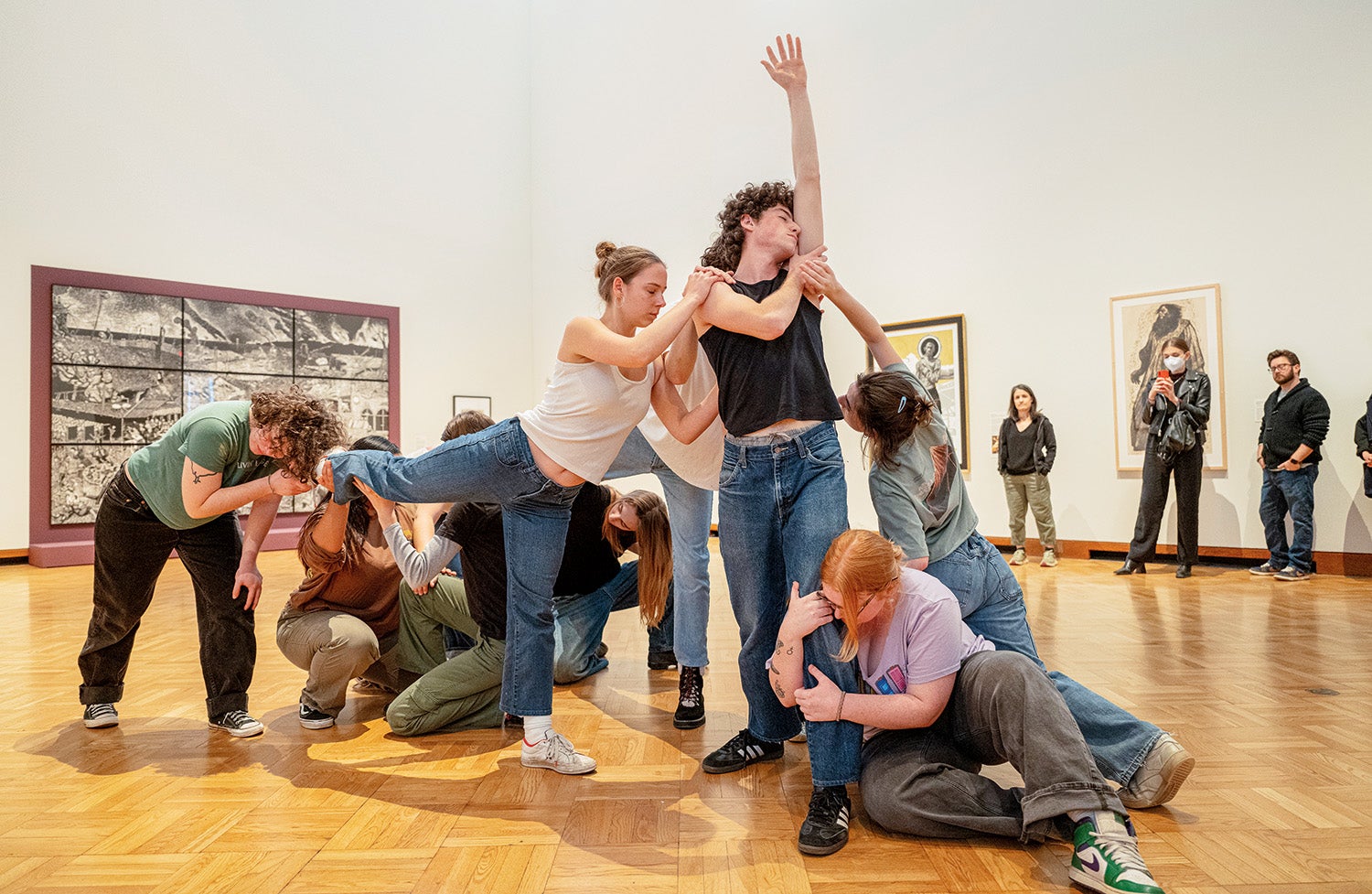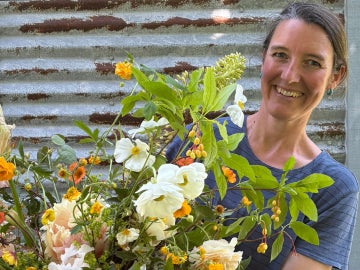Oberlin Alumni Magazine
The Body, The Host
An award-winning art exhibition challenges the prevailing narrative of the 1980s HIV/AIDS epidemic.
May 29, 2025
Alicia Smith-Tran '10

In 2022, Sam Adams, the Ellen Johnson ’33 Curator of Modern and Contemporary Art, started planning an Allen Memorial Art Museum exhibition centered on the 1980s HIV/AIDS epidemic—more specifically, one that challenged the prevailing narrative that the epidemic was only detrimental to gay white men. Adams knew Keith Haring was going to be included.
To art history major Cecil Pulley ’24, this was great news. A Mellon Mays Undergraduate Fellow, Pulley was a longtime admirer of the groundbreaking 1980s New York City-based pop artist. In fact, he conducted extensive research on Haring while at Oberlin, culminating in a project titled “Intersections of Queerness and Christianity in the Art, Life and Legacy of Keith Haring.”
During a formative meeting at Blue Rooster Bakehouse, Pulley and Adams “chatted about Haring and art and our mutual interests in this subject for a long time,” Pulley says. His Haring expertise ended up helping inform the final exhibition, The Body, the Host: HIV/AIDS and Christianity, which was open January 20 through December 15, 2024. So did many other voices: As Adams conceptualized the exhibition, they initiated discussions about potential artwork with Oberlin students and faculty and AIDS activists and faith leaders from Cleveland.
Patterns and themes soon emerged. “It became apparent that there’s a huge overlap in these two topics [HIV/AIDS and Christianity],” Adams says. “Queer Christian artists, many of whom were altar boys, were raised in Christian backgrounds. And then amid the outbreak of HIV in the 1980s, they were impacted by that and drew on their upbringings in the church and these altarpiece formats for processing some of that loss.”

On one side of the exhibition, Adams arranged more than a dozen selections focused on religious themes. Pieces included the 1983 Andy Warhol screen print Ingrid Bergman (The Nun); Cleveland native Jerome Caja’s 1993 painting Carrot Pietà, which was created out of acrylic ink, nail polish, eyeliner, and human ashes; and The Smallest Giant Makes an Easy Target, a 2023 charcoal drawing by Assistant Professor of Studio Art and Africana Studies Michael Boyd Roman that uses the story of St. Sebastian to depict present-day racist policing.
In an adjacent section, artworks visualized aspects of the HIV/AIDS epidemic. Pieces here included Andres Serrano’s 1989 print Ejaculate in Trajectory and multiple pieces by Haring. At the end of the gallery hall, Brendan Fernandes’ nearly floor-to-ceiling In PrEP we Trust?—part of a project of the Toronto-based organization AIDS Action Now!—featured prominently.
A wall separates these disparate topics, ensuring that visitors could see just half of the exhibition at a time. Despite this physical separation, Adams’ curation exemplified how these pieces are intertwined. “There’s many overlapping motifs that you’ll see around the effects of AIDS and of queerness—this kind of guilt and shame, plague, punishment, martyrdom, and then also salvation, resurrection, and redemption,” they say. “The exhibition is a bit like a Venn diagram.”
Reflecting on the impact of the exhibition, Adams says the interdisciplinary, cross-campus connections were particularly gratifying; in fact, some professors teaching biology, global health, and immunology classes started the semester at the museum. “It was their first meeting, and [students] were looking at the artwork,” they say. “That feels very, very Oberlin to me. Biology students are learning the history [of health crises] through the visual.”
Assistant Professor of Biology Gaybe Moore ’15 required students in their immunology and pathogenesis course to evaluate the written descriptions accompanying pieces in an effort to teach how to “critically assess writings about science.”
Many students chose the 2001 painting Index Study (red), by the late artist-activist Frank Moore—a work Adams included at the suggestion of Pulley. The piece features “a furry paw, insect, and frog legs, and human fingers with painted nails emerging from DNA strands,” its placard reads, alongside a brief description of HIV’s genetic sequencing.
“Some of the language [on the placard] is interesting because you have to convey the information to a general audience,” Gaybe Moore says. “But you also have to give enough science so they understand what’s going on.”
Diverting students’ gaze from the microscope to the museum prompted students to consider the potential for art to influence the general public’s perception of HIV and AIDS from both a social and scientific standpoint and to reflect on how art, science, and activism can work in concert.
Freya Kailing ’25 noted that dissecting the placards made her “think a lot about the number of pieces that were about the stigma of HIV and AIDS.” Providing people with scientific facts is “really important for reducing that stigma and having a social impact,” she adds.
Pike, a 2008 graduate who’s now an assistant professor of biology at Oberlin, encouraged similar lines of thinking in his infectious diseases course. When visiting the gallery, he asked his students, “Does art need to be scientifically accurate to be useful? Does it have to be visually appealing? Or is something being kind of shocking useful?” He then prompted students to consider how art can “inform health” and can also be “used as a form of protest.”
As another example, head baseball coach Johnathan Ray brought students from his first-year seminar on social justice in professional athletics to the exhibition to facilitate a discussion about how creative modalities can be implemented to speak out on issues of injustice.
The diverse identities represented in the exhibition led to meaningful conversations about creatives grappling with complex challenges. Ana Perry, assistant professor of modern and contemporary art history, brought students to the museum for several of her courses, including Approaches to Arts of the Americas and The Arts of Latin America in the 20th and 21st Centuries. “It’s been great to show students the importance of Latin American and Latinx art in the collection and show how a lot of [these artists] are queer,” she says—“and also how Latin American and Latinx artists interrogate religion when Catholicism is prominent in the culture.”
The Body, the Host won Best in Visual Arts at the 2024 POZ Awards, which honor representations of HIV and AIDS in media and culture. In November 2024, the Allen hosted a symposium of artists, historians, and activists such as Peter Staley ’83 for discussions and speeches on the exhibition’s themes.
In addition, student dancers, actors, and musicians performed in the gallery. “Performance in general is kind of new for us [as curators],” says Adams. “It was so important to me that the work is not static and in the past and that we bring liveness and action and movement into the galleries.”
The Body, the Host also became an unforgettable finale to Pulley’s time as an undergraduate at Oberlin: He authored two placards in the exhibition. “What a cool thing,” Pulley says, “for my parents to come to commencement and walk through the museum and see my name on the wall.”
Alicia Smith-Tran ’10 is a writer and associate professor of sociology and comparative American studies.
This story originally appeared in the Spring 2025 issue of the Oberlin Alumni Magazine.
You may also like…
Just Jewels
Anna Bario ’03 and Page Neal ’04 build their jewelry brand around fair sourcing, sustainability, and heirloom-quality design.
Banking on Sustainability
Former Oberlin basketball star Christian Fioretti ’20 applies his lifelong concern for the environment to a career in sustainability.
Lovely and Local
By building bouquets from sources close to home, Annika McIntosh ’01 of Hazel Designs reduces the floral industry’s environmental footprint.





